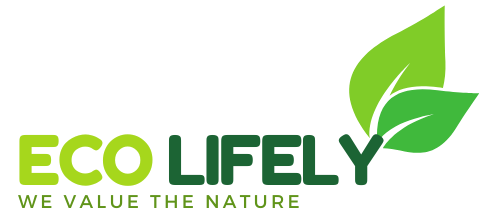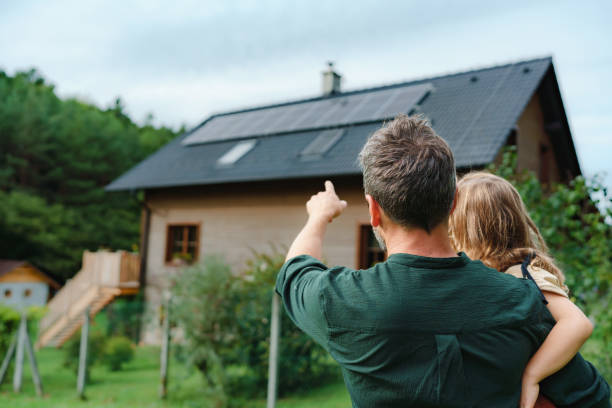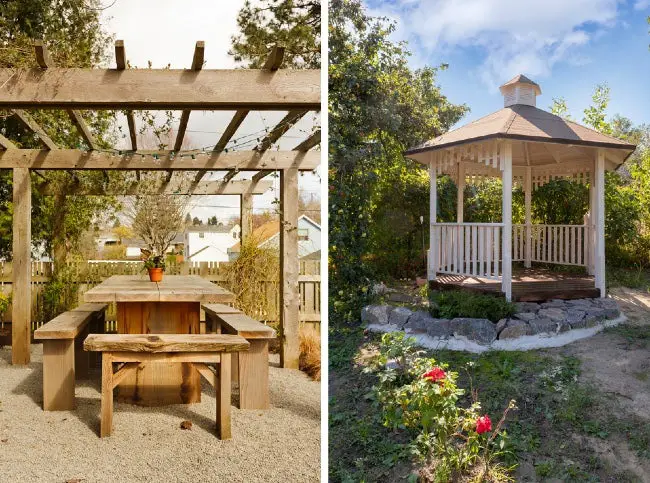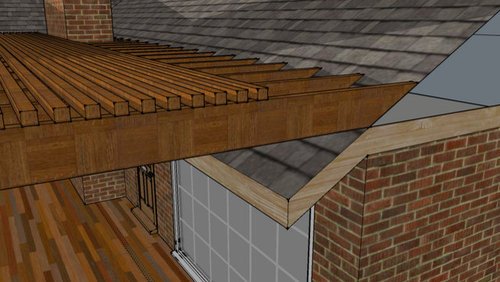How to build a sustainable home? Building a sustainable home is not just a trend—it’s a crucial step towards reducing our environmental impact, saving money, and improving our quality of life. Did you know that sustainable homes can reduce energy consumption by up to 60% compared to conventional homes? This guide will walk you through the essential steps of planning, constructing, and maintaining a sustainable home, ensuring you create a living space that is not only eco-friendly but also comfortable and cost-effective.
A sustainable home is designed to minimize environmental impact by using resources efficiently, reducing waste, and promoting healthy living environments. The benefits are manifold: from significant energy and water savings to improved indoor air quality and reduced carbon footprint. This journey starts with careful planning, where factors like site selection and design principles play a pivotal role in ensuring your home is optimized for sustainability.
Choosing the right building materials is crucial. Opt for recycled, renewable, and locally sourced materials to minimize environmental impact and support local economies. Energy efficiency is another cornerstone of sustainable living. Proper insulation, energy-efficient windows and doors, and the use of ENERGY STAR-rated appliances can drastically cut down your energy usage. Incorporating renewable energy sources such as solar, wind, or geothermal energy further reduces reliance on non-renewable resources.
Water conservation is equally important. Implementing low-flow fixtures, utilizing rainwater harvesting systems, and practicing xeriscaping with native plants can significantly reduce water consumption. Additionally, improving indoor air quality through proper ventilation, non-toxic materials, and air-purifying plants enhances health and comfort.
Reducing waste through effective recycling, composting, and mindful construction practices contributes to sustainability. Adopting sustainable living practices in daily routines and maintaining your home diligently ensures that your efforts are long-lasting.
This guide includes detailed case studies, expert insights, and interactive elements to provide you with a comprehensive understanding of sustainable home building. Whether you’re starting from scratch or looking to upgrade your current home, our tips and strategies will help you make informed decisions that benefit both you and the planet. So, let’s embark on this journey to create a home that reflects your commitment to sustainability and a better future for all.

Planning Your Sustainable Home
Planning is a crucial step in building a sustainable home. This stage involves making informed decisions about the location, design principles, and initial layout that will maximize efficiency and minimize environmental impact. Here’s a detailed guide on how to effectively plan your sustainable home.
1. Site Selection
Factors to Consider:
Climate: Choose a site that leverages the local climate to reduce heating and cooling needs. For instance, a south-facing slope can maximize solar gain in colder climates.
Topography: Use natural land contours to aid in water drainage and reduce the need for extensive landscaping.
Local Regulations: Ensure that your plans comply with local zoning laws and building codes that may influence your design choices.
Tip: Select a site that maximizes natural sunlight and minimizes the impact on local ecosystems. According to the U.S. Department of Energy, passive solar design can significantly reduce heating and cooling costs by utilizing the sun’s energy U.S. Department of Energy – Passive Solar Home Design.
2. Design Principles
Passive Solar Design:
Orientation: Position the home to maximize solar gain during winter and minimize heat during summer. Ideally, the long axis of the house should run east-west.
Windows: Place larger windows on the south-facing side and use overhangs or shades to prevent overheating in summer.
Thermal Mass: Incorporate materials like concrete or stone inside the home to absorb and store heat during the day and release it at night.
Natural Ventilation:
Cross-Ventilation: Design windows and openings to allow fresh air to flow through the home, reducing the need for air conditioning.
Stack Effect: Utilize high ceilings and operable skylights to allow warm air to rise and escape, drawing cooler air in from lower openings.
Tip: Design your home to make the best use of natural light and wind for heating and cooling. The Whole Building Design Guide (WBDG) emphasizes the importance of site-specific design to optimize energy performance and occupant comfort Whole Building Design Guide – Sustainable Design.
3. Initial Layout and Space Planning
Efficient Space Use:
Compact Design: A more compact home reduces the materials needed for construction and the energy required for heating and cooling. Consider multi-functional spaces to optimize the use of every square foot.
Zoning: Group rooms with similar heating and cooling needs together. For example, place bedrooms on the cooler north side and living areas on the warmer south side.
Future-Proofing:
Flexibility: Design spaces that can easily be adapted for different uses over time, which reduces the need for future renovations.
Accessibility: Incorporate universal design principles to ensure the home is accessible to people of all ages and abilities.
Tip: Plan for the long term by designing flexible and adaptable spaces. The National Institute of Building Sciences recommends integrating sustainable design principles early in the planning process to achieve better performance and cost savings National Institute of Building Sciences – Integrating Sustainable Design.
4. Incorporating Nature
Landscape Integration:
Native Plants: Use native plants in your landscaping to reduce water usage and provide habitat for local wildlife.
Green Spaces: Incorporate green roofs or walls to improve insulation and reduce the heat island effect.
Water Management:
Rainwater Harvesting: Plan for systems that capture and store rainwater for irrigation and non-potable uses.
Permeable Surfaces: Use permeable materials for driveways and walkways to reduce runoff and recharge groundwater.
Tip: Integrate natural elements into your home’s design to enhance sustainability. The American Society of Landscape Architects (ASLA) highlights the benefits of using native plants and green infrastructure for sustainable site development American Society of Landscape Architects – Sustainable Residential Design.
Sustainable Building Materials
Choosing sustainable building materials is a critical aspect of constructing an eco-friendly home. These materials minimize environmental impact, reduce waste, and often provide superior performance. Here’s a detailed guide on selecting and using sustainable building materials:
Recycled Materials
Benefits:
- Environmental Impact: Using recycled materials reduces the need for virgin resources, thereby decreasing energy consumption and greenhouse gas emissions associated with manufacturing new materials.
- Waste Reduction: Diverts waste from landfills and gives materials a second life.
Examples:
Recycled Steel: Steel can be recycled multiple times without losing its strength, making it ideal for structural components.
Tip: Recycled steel is commonly used in framing and roofing, reducing the need for new steel production.
Reclaimed Wood: Salvaged wood from old buildings or shipping pallets can be repurposed for flooring, beams, and furniture.
Tip: Reclaimed wood not only reduces waste but also adds unique character and history to your home.
Recycled Plastic: Plastic waste can be turned into building materials like composite lumber for decking and outdoor furniture.
Tip: Look for products made from high percentages of post-consumer recycled plastic.
According to the Environmental Protection Agency (EPA), using recycled materials can significantly lower the overall environmental impact of construction EPA – Sustainable Materials Management.
Renewable Materials
Benefits:
Sustainability: Renewable materials are sourced from resources that can regenerate quickly, ensuring a steady supply without depleting natural reserves.
Carbon Sequestration: Many renewable materials, like wood, capture and store carbon dioxide, helping to mitigate climate change.
Examples:
Bamboo: Bamboo grows rapidly and can be harvested sustainably, making it an excellent choice for flooring, cabinetry, and furniture.
Tip: Use bamboo products that are certified by the Forest Stewardship Council (FSC) to ensure responsible sourcing.
Cork: Harvested from the bark of cork oak trees, which regenerate, cork is used for flooring, insulation, and soundproofing.
Tip: Cork is naturally resistant to mold and mildew, making it a healthy choice for indoor environments.
Straw Bales: Used as insulation and structural walls, straw bales are a byproduct of agriculture, making them a low-cost, renewable resource.
Tip: Ensure straw bales are properly sealed and protected from moisture to maintain their insulating properties.
The Forest Stewardship Council (FSC) certifies that wood and other forest products are sourced from responsibly managed forests FSC – Certified Products.
Local Materials
Benefits:
Reduced Transportation Emissions: Sourcing materials locally reduces the carbon footprint associated with transporting materials over long distances.
Support for Local Economies: Purchasing local materials supports regional businesses and economies.
Examples:
Local Stone: Using stone sourced from nearby quarries for foundations, walls, and landscaping reduces transportation emissions.
Tip: Incorporate local stone into your design to harmonize your home with the natural landscape.
Adobe: In arid regions, adobe made from local clay and straw is a traditional building material that provides excellent thermal mass.
Tip: Adobe homes stay cool in the summer and warm in the winter due to their high thermal mass.
The U.S. Green Building Council (USGBC) emphasizes the importance of using regional materials to reduce environmental impact and support local economies USGBC – Regional Materials.
Low-VOC and Non-Toxic Materials
Benefits:
Healthier Indoor Air Quality: Low-VOC (volatile organic compounds) and non-toxic materials reduce the release of harmful chemicals, improving indoor air quality.
Environmental Safety: These materials are often less harmful to the environment during production and disposal.
Examples:
Low-VOC Paints and Finishes: These products emit fewer pollutants, making them safer for indoor use.
Tip: Choose low-VOC or zero-VOC paints and finishes to reduce indoor air pollution.
Natural Insulation: Materials like wool, cotton, and cellulose are effective insulators that do not off-gas harmful chemicals.
Tip: Use natural insulation to enhance indoor air quality and provide excellent thermal performance.
The Environmental Protection Agency (EPA) highlights the benefits of using low-VOC materials to improve indoor air quality and reduce health risks EPA – Indoor Air Quality.
By choosing recycled, renewable, local, and low-VOC materials, you can significantly reduce the environmental impact of your home construction. These sustainable materials not only promote a healthier living environment but also contribute to a more sustainable future. For further information and detailed guidelines, refer to trusted sources like the EPA, FSC, and USGBC.
Energy Efficiency
Energy efficiency is a crucial aspect of sustainable home construction, focusing on minimizing energy consumption while maximizing performance. By integrating efficient technologies and design principles, homeowners can reduce their environmental footprint and energy costs significantly. Here’s how you can achieve energy efficiency in your sustainable home:
Insulation and Thermal Mass: Efficient insulation and thermal mass play key roles in maintaining stable indoor temperatures. Insulation materials like cellulose, fiberglass, or spray foam should be strategically installed in walls, floors, and roofs to minimize heat transfer. Thermal mass materials such as concrete or adobe can absorb and store heat, reducing the need for active heating and cooling.
High-Performance Windows: Opt for energy-efficient windows with low-emissivity (low-E) coatings and double or triple glazing. These features help to minimize heat loss during winter and reduce heat gain in summer, enhancing overall comfort while reducing HVAC (Heating, Ventilation, and Air Conditioning) energy use.
Passive Solar Design: Incorporate passive solar design principles to harness natural sunlight and heat. This includes orienting the home to maximize solar exposure, using shading strategies like overhangs or deciduous trees to control solar gain, and incorporating thermal mass to store solar heat for release during cooler periods.
Energy-Efficient Appliances and Lighting: Equip your home with ENERGY STAR certified appliances and LED lighting fixtures. These products consume significantly less energy than their conventional counterparts, contributing to long-term energy savings.
Renewable Energy Systems: Consider integrating renewable energy systems such as solar panels or wind turbines to generate electricity onsite. These systems can supplement or even eliminate reliance on grid-based electricity, further reducing environmental impact and utility costs.
Smart Home Technology: Utilize smart home technologies like programmable thermostats and energy monitoring systems. These tools enable precise control over energy consumption, allowing homeowners to adjust settings based on occupancy patterns and energy demand.
Sources of Information:
- U.S. Department of Energy (DOE): Provides guidelines and resources on energy-efficient home design and technologies.
- ENERGY STAR: Offers insights into energy-efficient products and practices for sustainable homes.
- Green Building Councils: Local councils often provide regional-specific guidelines and certifications for sustainable building practices.
- Case Studies and Research: Referencing case studies and research papers from reputable institutions can provide real-world examples and data-driven insights into the benefits of energy-efficient home design.
By implementing these strategies, homeowners can create a sustainable home that not only reduces environmental impact but also enhances comfort and saves on long-term operating costs.
Renewable Energy Sources
Integrating renewable energy sources into your home not only reduces reliance on fossil fuels but also promotes environmental sustainability. Renewable energy technologies harness natural resources that are constantly replenished, such as sunlight, wind, and water, to generate electricity. Here are key renewable energy sources to consider for your sustainable home:
Solar Power: Solar energy is one of the most accessible and widely adopted renewable energy sources. Photovoltaic (PV) panels convert sunlight directly into electricity using semiconductor materials. Solar panels can be installed on rooftops or ground-mounted in areas with ample sunlight. Advances in technology have made solar panels more efficient and cost-effective over the years, offering homeowners a reliable source of clean energy.
Explore more about solar energy from the U.S. Department of Energy’s Solar Energy Technologies Office.
Wind Energy: Wind turbines convert kinetic energy from the wind into mechanical power, which is then converted into electricity. Wind energy is particularly viable in areas with consistent and strong wind patterns. Turbines can be installed individually or in wind farms, providing a scalable solution for generating electricity without emissions.
Learn more about wind energy from the National Renewable Energy Laboratory (NREL).
Hydroelectric Power: Hydroelectric power utilizes the flow of water to generate electricity. Dams or diversion structures are used to capture the energy from moving water, converting it into mechanical energy through turbines and then into electrical energy via generators. Hydroelectric power is a mature technology with significant potential for generating large amounts of clean electricity.
For more details on hydroelectric power, visit the International Hydropower Association.
Geothermal Energy: Geothermal energy harnesses heat from beneath the Earth’s surface to generate electricity or provide heating and cooling for buildings. Geothermal power plants utilize hot water or steam reservoirs to drive turbines and produce electricity. Geothermal heat pumps, on the other hand, use the stable temperature of the ground to heat or cool homes efficiently.
Explore further about geothermal energy from the U.S. Department of Energy’s Geothermal Technologies Office.
Bioenergy: Bioenergy involves using organic materials such as biomass, biogas, and biofuels to produce heat, electricity, or transportation fuels. Biomass, derived from plants and organic waste, can be burned directly or converted into biofuels like ethanol and biodiesel. Biogas is produced through anaerobic digestion of organic waste, generating methane for electricity and heat.
Learn more about bioenergy from the International Renewable Energy Agency (IRENA).
Implementing Renewable Energy in Your Home
Integrating renewable energy sources requires careful planning and consideration of factors such as local climate, available resources, and budget. Assessing your energy needs and consulting with renewable energy experts can help determine the most suitable technologies for your home.
By incorporating renewable energy sources, homeowners can reduce carbon emissions, lower energy costs over time, and contribute to a more sustainable future.
Water Conservation
Water conservation is a critical component of sustainable home design, aiming to reduce water usage, minimize waste, and promote the efficient use of water resources. Implementing water conservation techniques not only helps preserve this vital resource but also reduces utility bills and supports environmental sustainability. Here’s how you can achieve effective water conservation in your home:
Low-Flow Fixtures: Installing low-flow fixtures is one of the simplest and most effective ways to conserve water. Low-flow faucets, showerheads, and toilets use significantly less water than standard fixtures without compromising performance. For instance, low-flow showerheads use about 2.0 gallons per minute (GPM) compared to standard showerheads that use 2.5 GPM or more.
Dual-Flush Toilets: Dual-flush toilets provide two flushing options: a lower volume flush for liquid waste and a higher volume flush for solid waste. This system can save a substantial amount of water compared to traditional single-flush toilets, which use the same amount of water for all types of waste.
Rainwater Harvesting: Rainwater harvesting involves collecting and storing rainwater from rooftops and other surfaces for later use. This water can be used for irrigation, toilet flushing, and even laundry. Rain barrels and larger cistern systems can capture significant amounts of water, reducing the demand on municipal water supplies.
Learn more about rainwater harvesting from the U.S. Environmental Protection Agency (EPA).
Greywater Recycling: Greywater recycling systems capture water from sinks, showers, and washing machines and treat it for reuse in non-potable applications such as irrigation and toilet flushing. By reusing greywater, homeowners can reduce the amount of fresh water required for these purposes.
Explore greywater recycling guidelines from the Greywater Action.
Drip Irrigation Systems: Drip irrigation systems deliver water directly to the roots of plants, reducing evaporation and runoff. This method is highly efficient compared to traditional sprinkler systems and is ideal for gardens, lawns, and landscaping.
Discover the benefits of drip irrigation from the University of California Agriculture and Natural Resources.
Smart Water Meters and Leak Detection: Smart water meters and leak detection systems help monitor water usage in real-time and identify leaks quickly. These technologies provide homeowners with valuable insights into their water consumption patterns and help prevent water waste due to unnoticed leaks.
Learn more about smart water meters from the Alliance for Water Efficiency.
Implementing Water Conservation in Your Home
Effective water conservation requires a combination of technology, behavioral changes, and proper maintenance. Homeowners should regularly inspect plumbing systems for leaks, use water-saving fixtures and appliances, and consider landscape designs that reduce water usage. Additionally, educating household members about the importance of water conservation can foster long-term sustainable practices.
By implementing these water conservation strategies, homeowners can significantly reduce water consumption, lower utility bills, and contribute to the sustainable management of water resources.
Indoor Air Quality
Maintaining good indoor air quality (IAQ) is essential for a healthy and comfortable living environment. Poor IAQ can lead to various health issues, including allergies, respiratory problems, and overall discomfort. Here’s how you can ensure excellent indoor air quality in your sustainable home:
Ventilation Systems: Proper ventilation is crucial for circulating fresh air and removing pollutants from indoor spaces. Mechanical ventilation systems, such as heat recovery ventilators (HRVs) and energy recovery ventilators (ERVs), are effective at exchanging stale indoor air with fresh outdoor air while maintaining energy efficiency.
Learn more about ventilation systems from the U.S. Environmental Protection Agency (EPA).
Air Purifiers: Air purifiers equipped with HEPA (High-Efficiency Particulate Air) filters can capture up to 99.97% of airborne particles, including dust, pollen, mold spores, and pet dander. Some advanced models also feature activated carbon filters to remove odors and volatile organic compounds (VOCs).
Discover the benefits of air purifiers from the American Lung Association.
Non-Toxic Building Materials: Choosing non-toxic, low-VOC building materials and finishes helps reduce the emission of harmful chemicals indoors. Opt for paints, adhesives, and sealants labeled as low or zero VOC. Additionally, selecting natural materials like wood, stone, and wool can contribute to a healthier indoor environment.
Learn more about non-toxic building materials from the Green Building Supply.
Indoor Plants: Certain indoor plants are known for their air-purifying properties. Plants like spider plants, peace lilies, and snake plants can absorb pollutants and improve indoor air quality. However, it’s essential to choose plants that are safe for your household, especially if you have pets.
Explore the benefits of indoor plants from the NASA Clean Air Study.
Humidity Control: Maintaining optimal indoor humidity levels (30-50%) is crucial for IAQ. Excess humidity can lead to mold growth and dust mites, while low humidity can cause dryness and respiratory irritation. Use dehumidifiers in damp areas and humidifiers in dry conditions to keep humidity levels balanced.
Learn more about humidity control from the Centers for Disease Control and Prevention (CDC).
Regular Cleaning and Maintenance: Regular cleaning and maintenance of your home are vital for preventing the buildup of dust, allergens, and pollutants. Use a vacuum cleaner with a HEPA filter, dust surfaces frequently, and wash bedding and curtains regularly. Also, schedule routine maintenance for HVAC systems to ensure they function efficiently and do not circulate contaminants.
Discover cleaning tips for better IAQ from the American Cleaning Institute.
Implementing Indoor Air Quality Measures in Your Home
Ensuring good indoor air quality involves a combination of proper ventilation, the use of air-purifying devices, selecting non-toxic materials, and maintaining optimal humidity levels. Regular cleaning and the incorporation of indoor plants can further enhance IAQ. By implementing these measures, homeowners can create a healthier, more comfortable living environment that supports overall well-being.
Waste Reduction
Waste reduction is a fundamental aspect of sustainable living, focusing on minimizing the amount of waste generated and ensuring that any waste produced is managed responsibly. By adopting waste reduction strategies, homeowners can contribute to environmental sustainability, reduce landfill waste, and promote a circular economy. Here’s how you can achieve effective waste reduction in your home:
Reduce, Reuse, Recycle: The three Rs—Reduce, Reuse, Recycle—are the cornerstone of waste reduction. Reduce the amount of waste you generate by opting for products with minimal packaging and avoiding single-use items. Reuse items whenever possible, such as repurposing jars for storage or using cloth bags instead of plastic. Recycle materials like paper, glass, and plastics according to your local recycling guidelines.
Learn more about the three Rs from the U.S. Environmental Protection Agency (EPA).
Composting: Composting is an excellent way to manage organic waste and create nutrient-rich soil for your garden. Kitchen scraps like fruit and vegetable peels, coffee grounds, and eggshells, as well as yard waste like grass clippings and leaves, can be composted. Composting reduces the amount of organic waste sent to landfills and enriches soil health.
Discover composting techniques from the EPA’s Composting at Home Guide.
Bulk Purchasing: Buying in bulk reduces packaging waste and often saves money. Choose products that come in bulk or larger quantities to minimize the frequency of purchases and the associated packaging waste. This approach is particularly effective for non-perishable items like grains, legumes, and cleaning supplies.
Read more about the benefits of bulk purchasing from the Bulk is Green Council.
Sustainable Products: Opt for products made from sustainable, recyclable, or biodegradable materials. Look for certifications like Fair Trade, USDA Organic, and FSC (Forest Stewardship Council) when purchasing goods. Sustainable products are designed to have a lower environmental impact throughout their lifecycle.
Explore sustainable product options from the Sustainable Furnishings Council.
DIY Projects: Engage in DIY projects to repurpose and upcycle materials you already have at home. For example, you can turn old furniture into new pieces, create storage solutions from used containers, or fashion clothing from fabric scraps. DIY projects foster creativity and reduce waste.
Find DIY upcycling ideas from HGTV’s Upcycling Projects.
Electronic Waste Management: Properly managing electronic waste (e-waste) is crucial due to the hazardous materials found in electronics. Donate or recycle old electronics through certified e-waste recycling programs. Many retailers and municipalities offer e-waste recycling services.
Learn more about e-waste recycling from the Consumer Technology Association.
Implementing Waste Reduction Strategies in Your Home
Effective waste reduction involves a combination of mindful consumption, proper waste management, and creative repurposing. Educate household members about the importance of waste reduction and provide easy access to recycling and composting facilities. By implementing these strategies, homeowners can significantly reduce their environmental footprint and promote a more sustainable lifestyle.
Sustainable Living Practices
Adopting sustainable living practices is essential for reducing your environmental impact, conserving resources, and fostering a healthier lifestyle. By incorporating eco-friendly habits into your daily routine, you can contribute to the well-being of the planet while enhancing your quality of life. Here’s how you can integrate sustainable living practices into your home:
Energy Conservation: Reducing energy consumption is a key aspect of sustainable living. Simple actions like turning off lights when not in use, unplugging electronics, and using energy-efficient appliances can make a significant difference. Additionally, consider switching to LED bulbs and installing smart thermostats to optimize energy use.
Learn more about energy conservation from the U.S. Department of Energy.
Water Conservation: Water conservation practices help preserve this vital resource and reduce utility bills. Implementing measures such as fixing leaks, using water-efficient fixtures, and collecting rainwater for outdoor use can significantly cut down on water usage. Additionally, consider xeriscaping your garden with drought-resistant plants to minimize the need for irrigation.
Discover water conservation tips from the Water Use It Wisely Campaign.
Sustainable Transportation: Opt for sustainable transportation methods to reduce your carbon footprint. Walking, biking, carpooling, and using public transportation are excellent alternatives to driving alone. If you need a vehicle, consider investing in an electric or hybrid car to decrease greenhouse gas emissions.
Explore sustainable transportation options from the U.S. Environmental Protection Agency (EPA).
Eco-Friendly Diet: Adopting an eco-friendly diet can have a substantial impact on the environment. Reduce meat consumption, especially red meat, as livestock farming is a significant source of greenhouse gases. Incorporate more plant-based foods into your diet, and opt for locally sourced and organic produce to minimize the carbon footprint associated with food transportation.
Read more about sustainable eating from the World Wildlife Fund (WWF).
Waste Reduction: Minimizing waste is crucial for sustainable living. Embrace the principles of the three Rs: Reduce, Reuse, and Recycle. Compost organic waste, recycle materials like paper, glass, and plastics, and avoid single-use products. Additionally, support companies that prioritize sustainable packaging and production practices.
Learn about waste reduction strategies from the U.S. Environmental Protection Agency (EPA).
Sustainable Shopping: Make conscious choices when shopping by supporting eco-friendly brands and products. Look for certifications such as Fair Trade, USDA Organic, and Energy Star, which indicate sustainable and ethical production practices. Buying second-hand or upcycled items is another great way to reduce waste and promote a circular economy.
Discover sustainable shopping tips from Green America.
Home Gardening: Growing your own food is a rewarding way to live sustainably. Home gardening reduces the need for store-bought produce, decreases the carbon footprint associated with food transportation, and ensures you have access to fresh, organic vegetables and herbs. Additionally, gardening promotes biodiversity and supports local ecosystems.
Get started with home gardening tips from the National Gardening Association.
Mindful Consumption: Practicing mindful consumption involves being aware of your purchasing decisions and their environmental impact. Avoid impulse buys, choose high-quality products that last longer, and prioritize experiences over material possessions. This approach not only reduces waste but also fosters a more intentional and fulfilling lifestyle.
Learn about mindful consumption from the Sustainable Consumption and Production (SCP) Clearinghouse.
Implementing Sustainable Living Practices
Incorporating sustainable living practices into your daily routine can lead to significant positive changes for both the environment and your well-being. Start with small steps, such as conserving energy and water, and gradually adopt more sustainable habits. Educate yourself and your household about the importance of sustainability and make conscious choices that support a healthier planet.
By committing to sustainable living practices, homeowners can reduce their environmental impact, save money, and create a healthier, more sustainable future.
Case Studies and Examples
Examining real-world case studies and examples of sustainable homes can provide valuable insights and inspiration for your own projects. These case studies demonstrate practical applications of sustainable practices, showcasing the benefits and challenges encountered along the way. Here are some noteworthy examples:
BedZED (Beddington Zero Energy Development), UK: BedZED is one of the most well-known sustainable housing projects in the world. Located in London, it comprises 100 homes, office space, and community facilities. The development focuses on energy efficiency, renewable energy, and sustainable living. BedZED features super-insulated walls, triple-glazed windows, and solar panels. It also promotes the use of public transportation, cycling, and walking over car usage.
Learn more about BedZED from the Bioregional BedZED Case Study.
The Bullitt Center, USA: The Bullitt Center in Seattle, Washington, is often referred to as the “greenest commercial building in the world.” It was designed to meet the rigorous standards of the Living Building Challenge. The building includes features such as a rainwater harvesting system, composting toilets, solar panels, and an energy-efficient heating and cooling system. The Bullitt Center aims to be energy and water self-sufficient.
Discover more about the Bullitt Center from the Bullitt Center Official Website.
Hockerton Housing Project, UK: The Hockerton Housing Project is a self-sufficient housing development consisting of five earth-sheltered homes in Nottinghamshire, England. The homes are designed to be energy-efficient, using passive solar heating, natural ventilation, and rainwater harvesting. The project also includes a wind turbine and solar panels to generate renewable energy. Residents grow their own food and manage waste sustainably.
Learn more about the Hockerton Housing Project from the Hockerton Housing Project Official Website.
The Edge, Netherlands: The Edge is an innovative and sustainable office building located in Amsterdam. Known for its smart technology and energy efficiency, the building uses a combination of solar panels, LED lighting, and a sophisticated climate control system to minimize energy consumption. The Edge also promotes sustainable transportation options, such as cycling and electric car charging stations.
Explore details about The Edge from the Deloitte The Edge Case Study.
Ecolonia, Netherlands: Ecolonia is a residential neighborhood in Alphen aan den Rijn, Netherlands, designed with sustainability in mind. The development features 101 homes built with energy-efficient materials and designed to maximize natural light and ventilation. Renewable energy sources, such as solar panels and heat pumps, are integrated into the homes. The neighborhood also emphasizes water conservation and waste management.
Find out more about Ecolonia from the European Commission Ecolonia Project.
Learning from Case Studies
These case studies illustrate the diverse approaches to sustainable building and living. By studying these examples, you can gain insights into effective strategies for energy efficiency, water conservation, renewable energy integration, and sustainable lifestyle practices. Each project demonstrates the potential benefits of sustainability, including reduced environmental impact, cost savings, and enhanced quality of life.
Implementing lessons learned from these case studies in your own sustainable home project can help you avoid common pitfalls and optimize your design for maximum efficiency and sustainability. Whether you are renovating an existing home or building a new one, these real-world examples provide a wealth of knowledge and inspiration.
Conclusion
Building a sustainable home is not just about reducing environmental impact; it’s about creating a healthier, more efficient living space for you and future generations. Throughout this guide, we’ve explored various aspects of sustainable home construction and living practices, from energy efficiency and water conservation to waste reduction and eco-friendly materials.
By incorporating these sustainable principles into your home design and daily routine, you can make a positive impact on the planet and enjoy numerous benefits, including lower utility bills, improved indoor air quality, and a greater sense of environmental responsibility.
Moving Forward
As you embark on your journey towards sustainable living, consider the following suggestions:
Continuous Learning: Stay informed about new advancements and best practices in sustainable building and living. The field of sustainability is constantly evolving, and there are always new technologies and strategies emerging.
Community Engagement: Join local sustainability groups or online forums to exchange ideas and experiences with like-minded individuals. Community support can provide valuable insights and encouragement throughout your sustainable living journey.
Feedback and Suggestions: If you have any feedback or suggestions on how to improve this guide or if you have ideas for additional topics you’d like to explore, please share them in the comments below. Your input can help us create more informative and valuable content for our readers.
Embracing Sustainability
Building a sustainable home is a rewarding endeavor that requires dedication and commitment. Whether you’re renovating an existing property or starting from scratch, every small step towards sustainability counts. From choosing energy-efficient appliances to cultivating a garden, each decision contributes to a more sustainable future.
Thank you for exploring the world of sustainable living with us. Together, we can create homes that not only meet our needs but also respect the planet we call home.

“My name is Leo Jacob, and I hold a Bachelor of Science degree with Honors in Applied Environmental Science and Sustainability from the University of the West of Scotland. Since childhood, I’ve been passionate about living an eco-friendly life. After completing my studies, I dedicated myself to finding simple ways to lead a more environmentally conscious lifestyle. I launched ecolifely.com to share my educational background and practical experiences with everyone, hoping to inspire others to join me in creating a greener, more sustainable world.”












Leave a Reply